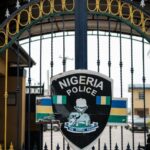At the height of the rainy season the feeder roads in Baruten and Kaiama local governments of Kwara state are blocked, farms are submerged and the people are restricted to their communities until the waters recede. With farmers as guides in both LGAS, an underreported story is revealed. In Gwariawizi, villagers’ tax themselves every year to buy a canoe. Many swim every day with basins of tomatoes or other harvests from villages which have been cut off. This is the unusual way the locals evacuate the tomatoes harvest to nearby communities and markets. Along the Kaiama-Degeji road, part of a bridge built by farmers has collapsed, and, in a reversal of roles, young men physically lift the motorcycle taxis across the river for a fee. At harvest time farmers make three trips conveying the harvest, instead of one. Everything must be done in bits and pieces or the vehicle sinks. Flooded feeder roads signify the slow impoverishment, neglect and exclusion of the people in this massive border region, equivalent to half of the land mass of Kwara state. All this raises urgent questions about the local government system in this part of Borgu. Local governments are allocated billions of Naira from the federation account and represent the tier of government closest to the people.
The man swimming in the river has a basin full of tomatoes by his side. It is one of the wonders of this rather unremarkable small village in Kaiama local government area of Kwara state. Gwariawizi produces huge quantities of yams, soya beans, tomatoes, and rice. To get them to the market, however, especially during the rainy seasons, there are few choices. Throughout Kaiama region, a lush agricultural landscape with unknown kilometres of water and possibly canals, water is the standard mode of travel. For farmers who must get their products to market while still vibrant and attractive, it is swim or sink. Many of the villages have made heroic collective efforts including setting up community canoe services (all fully paid by the people themselves through levies and informal taxations) to ease the difficulties of movement. Except that when it is the rainy season, the rivers begin to overflow as much as the farmlands become flooded.
Yakub Musa Bawa, the Village Head of Gwariawizi, describes it as the reality ‘we all live with every day, every year.’ Farmers sometimes lose part of the harvest to the flooded river when trying to swim and occasionally when canoes carrying them capsize. Gwariawizi village has just one canoe which serves its many households. It is their means of getting to Ajuba, a neighbouring village.
“I swim from Ajuba to Gwariawizi every day with a basin of tomatoes, and I have been doing this for five years. I make the trip several times each day. There are many of us who swim with the tomato harvest as well as other crops. We do this because the road is not motorable,” says Gabriel Anu, a farmer. In Gwariawizi, it is either you learn to swim with your farm produce, or you fail to learn and make no earning.
- Bauchi APC reverses suspension of ex-gov Abubakar
- Two killed as Russia launches fresh missile attack on Ukraine
Sulaiman Gado Yusuf, Chairman, Kaiama local government, boasts about the industriousness of the local farmers. Each farmer has many hectares of land where a diversity of crops is grown. The people are hardworking, and the land is fertile. The only problem however is that Gwariawizi, like many parts of the local government, is lacking in good feeder roads, which makes the farmers vulnerable. It is an open secret that a third or more of the farm yields in Kaiama perish every year. The highpoint of the losses is during the rainy season.
Kaiama is nature’s gift to its inhabitants. It is made up of network of villages and rivers. It is the sort of place to be considered alluvial. Perhaps it is because agriculture here is simple and basic. Any hoe or cutlass will do, and the yield is always plentiful.
There are one hundred and fifty feeder roads cutting across the 10 wards that make up Kaiama local government. Some of the roads are no more than muddy footpaths. Nonetheless, they link villages to the farms and to the many rivers that criss-crosses the villages. Otherwise, much of the roads are in a disastrous state. It is common to see goats, poultry, farming tools and sacks of rice loaded on Okada – the motorcycle taxis. Okada riders have detailed mental maps of the landscape. They get to hamlets, villages, streams, rivers and markets.
Three federal roads converge on Kaiama. These are the Kaiama-Kisi, Kaiama-Kosubosu and Kaiama-Wawa roads and all of them are in bad shape. There are numerous failed portions, including collapsed bridges and culverts, making a journey to this border region, unnecessarily long and tedious. Feeder roads where vehicles laden with foodstuff are either stuck in mud or sinking, are also linked to the federal roads.
Kaiama has a land mass of 6,971 square kilometres and a population of 124,164 (according to the 2006 census). According to the Federation Accounts Allocation Committee (FAAC) data, twenty-four billion, two hundred and forty-three million, three hundred and seventy-one thousand, six hundred and sixty six, Naira, sixty two kobo (N24,243,371,666.62) went to Kaiama local government between 1999 and 2017.
‘Black hole’
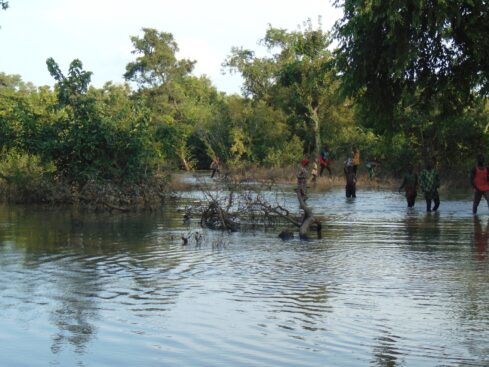
A flooded road leads to Mallam Gado village
Throughout the Kaiama hinterland can be found women and children washing clothes by the side of fast running streams and rivers, and drying clothes on the abundant vegetation nearby.
Development experts have long identified the connection between democratic deficit, marginalisation and lack of infrastructure, which combined deepens poverty. Writing specifically about the Borgu region in his book, Partitioned Borgu: State, Society and Politics in a West African Border Region, published in 2019, Dr Hussaini Abdu, who is currently country director, CARE International in Nigeria, notes that “Because of the difficulties in physical access and assessment, projects are hardly inspected, services hardly supervised, researchers hardly visit, media and major civil society organisations hardly cover, leading to a black hole that serves well the underhand who thrive in the dark.”
Swimming farmers
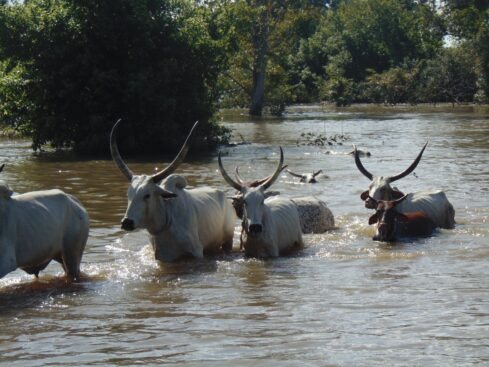
Cows pass through the river near Ilesa Baruba. (1)
Every year at the height of the rainy season the people of Gwariawizi convey the tomato and yam harvest out of their community, not by hiring vehicles which would be the normal thing to do, but by swimming with the harvest across the river Tese. They are the swimming farmers of Gwariawizi. When the rains intensify the river swells, freezing development and limiting the evacuation of crops at harvest time. This is a logistical nightmare to any farmer, and an essential link in the local supply chain collapses.
Bawa sheds light on flooded farms, a recurring problem in the area “if you look at our yams, there is no yam farm again. The river has completely covered it. I have not seen my farm for one month. I am a farmer without a farm. It is located at a flooded point after this river.” Yusuf explains “sixty to seventy percent of farmers in Kaiama lost their crops as a result of the heavy downpour this year.”
In parts of nearby Tese village a number of soya beans farms were recently submerged with losses amounting to well over five hundred thousand Naira (N500,000).
Absent state
“Sometimes, up to fifty persons will be in the river conveying their buckets of tomatoes or other farm products to Gwariawizi”, continues Bawa, recalling a scene he has witnessed many times. Dr. Abdu comments on life in this part of Kwara “In substantial segments of the region, beyond the headquarters of the local government areas, districts and a few major villages, the state is practically absent in all material senses.”
An absent state pushes the people of Gwariawizi to resort to self-help. The Village Head adds that sections of a bridge constructed by the community across the river, have collapsed. “The Gwariawizi-Ajuba road leads to numerous villages in these parts. You can use it to get to Kanikoko, Budu Doka, Salun and many farming communities,” he reveals.
Members of the local vigilante keep the peace in the ‘ungoverned space’ where electricity supply is either very poor or non-existent. The vigilante is friendly, carry long dane guns, may bear charms for protection, and are more numerous than the regular policemen.
‘not more than 5’
“The communities that don’t have health care centres are more than the communities that have health care centres. Out of fifty communities within Bani, the communities that have health care centres are not more than five. Out of thirty-five communities in Adena, the communities with health care centres are not more than six,” says Ibrahim Ibn Mohammed, Kiwazi of Wazibe, speaking on infrastructural challenges in Kaiama.
August to November represents the peak period for the tomato harvest in Gwariawizi. A basket of tomatoes costs forty thousand Naira (N40,000). Nearby, farmers are busy sorting and loading the tomato harvest into a number of parked buses as the interview continues. Children play as their mothers arrange the harvest into baskets.
Canoe tax

A very active economy has arisen around the collapsed bridge along the Degeji road
Many years of neglect has taught the farmers of Gwariawizi have learnt a practical lesson: They now tax themselves every year to buy a canoe. A brand-new canoe costs one hundred thousand Naira (N100,000). This community, made up of one thousand five hundred (1500) farming households, is usually cut off from other villages as the rainy season peaks, sometimes for upwards of two months.
According to the Village Head “Every person living in our community is taxed five hundred Naira (N500), one thousand Naira (N1000) or two thousand Naira (N2000), depending on the capacity of the individual. With the canoe we are able to evacuate farm products. Without it, we won’t be able to transport the harvest, and we will be stuck here until the waters recede.” The canoe is constructed in Kisi in neighbouring Oyo state and conveyed to Gwariawizi.
It costs five hundred Naira to convey a passenger by canoe from Gwariawizi to Ajuba, while the amount paid to transport a motorcycle taxi by canoe is two thousand Naira.
In addition, the people strive to protect their property. “The villagers of Gwariawizi ensure that their canoe does not convey more than five persons at any given time, or else it will sink,” says the Village Head. This has occurred in the past and there are a number of motorcycle taxis and canoes on the riverbed. It costs sixty thousand Naira N60,000) to raise a canoe back to the surface of the river.
No heavy-duty equipment
Sulaiman Gado Yusuf, Chairman Kaiama local government speaks on the feeder roads “The works department of the local government cannot do anything to save the feeder roads because we don’t have heavy duty equipment that can be used to maintain the roads.” A non-functional local government is an impossible burden on the people.
‘Monkeys too’
Alhassan Aminu who lost four million Naira worth of rice when his farm was flooded, comments on the river as a source of drinking water. His words “In the dry season both human beings and cows drink from the same source. Monkeys also drink from this same source. Some people boil the water, some don’t.” Many contract water borne diseases, he tells me.
On the impact of the bad roads, he says “At times women will place their children on their backs and swim with them in order to take them to school. You will see women swimming with the children on their backs, as well as with a bucket of tomatoes. On other occasions they will put the child in a basin and swim across the river.” Women live burdened lives in the forgotten parts of Nigeria.
No govt presence
Aminu who is the Assistant Village Head of Gwariawizi, continues “We need at least three additional canoes in Gwariawizi. We tax ourselves every year to buy a canoe. There is no government presence here. People pass through the river both in the daytime as well as by night, whether there is a canoe or not. There are guides who can be summoned even at 3.00 am or 4.00am to help with a crossing.”
He adds ” There is no electricity in Gwariawizi. Those who have money, buy generators. Those who cannot will remain in the dark.” This is the basic tenor of life in one of Nigeria’s ungoverned spaces.
Aminu laments “I have been contributing to the purchase of canoes throughout my life. Government does not provide any incentive or support. Politicians come to our village and promise to provide canoes during campaigns, but nothing is ever done.”
Ten communities around Gwariawizi tax themselves each year to buy canoes, but the canoes hardly suffice. Lack of a canoe means that the communities will be cut off from the local government for long periods in the rainy season.
At Tese village, Isa Mohammed, son of the village Head informs us that Tese river always fills up at this time of the year.
‘Nobody can go out’
We go on motorcycle taxis to get to the river. Young men wade through the river, and to our left and right are flooded rice farms with the crop turning grey, with sections of green.
“Nobody wants to know whether you lost crops or not,” informs Aminu, standing in the river and shaking his head.
“When the river is full, nobody can go out of Tese village or come in. We can easily go to Yabai, Tinini, Budu, Kanibaa, and Mallam Gado, if the river is not full. We don’t have a canoe here, and we have not made attempt to raise the money. Many children in the communities are missing out on education. Life grinds to a halt for many people whenever the river is full,” Mohammed states.
Another Canoe tax
Inhabitants of Mallam Gado village taxed themselves to construct a wooden bridge along the Kamen River, located in a leafy enchanting section of the Gwaria-Mallam Gado road. Part of the bridge stretches across a bit of the river. Recent floods damaged the wooden bridge and motorcycle taxis struggle to pass through the river, while locals walk through.
Every one aims to get to what is left of the bridge. It is a bit of a struggle passing through the river as the current is quite strong. A few of the villagers coming from Mallam Gado place part of the yam harvest on their heads and walk across. This is a common sight at the spot every hour.
“A lot of people have farms at Mallam Gado, but they live at Gwaria. They cannot cross to go to their farms because the river is often flooded. Without going to their farms, they cannot weed the farms or harvest the crops. To make matters worse every year the bridge at river Kamen is renovated by the people of Mallam Gado, and the river will come and take parts of it away,’ reveals Aminu.
‘no longer motorable’

Farmers in Kaiama raised the sum of N12m to build the bridge across the Woro river a few years ago.
” One of the major feeder roads where we have many farmers is the Kaiama-kanikoko-Degeji-Kokoji road. There is another road that links from there to Bani. The road links to Adena. All these roads are no longer motorable. If you are come back to Kaiama, the road that will take you to Gbajibo, is no longer motorable. There used to be a road from Nanu linking to Kinikini, it too is no longer motorable. The road from Moshe Gada to other areas is no longer motorable. The road that links from Woro to Degeji is also no longer motorable. There are many like these, and I am just picking a few,” states Ibn Mohammed opening up on the state of feeder roads in the local government.
Bumper harvest, bad roads
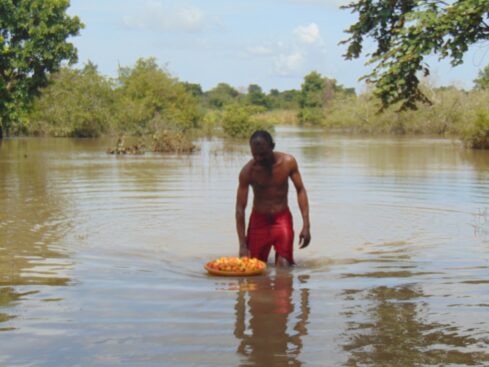
Feeder roads are submerged, and a farmer rises from the river with his tomato harvest
He confesses “We are facing a lot of problems with the farmers. There is no way they can carry their goods to the markets, except those who have farms close to the communities. This year we have a bumper harvest, but there is no way farm products can be brought to the market. If you want to bring it to the market, you will end up spending more than what you are coming to sell.” The rural agricultural economy resembles an ecosystem, and if one part ails then the whole may collapse.
“The government that is closer to the people today is the local government. A situation where the local government cannot fix a culvert or a feeder road, then it means that something is wrong somewhere. We have to encourage the state government to fund the local governments. That is why you see sometimes the farmers resist the payment of revenue,” adds Ibn Mohammed.
Collapsed bridge
There is much activity at the scene when we arrive. We are told that five hundred motorcycle taxis are lifted through the river every day by young men, providing an idea of the stunning river side economy that has grown around the collapsed bridge. A huge multilingual population moving excitedly, gathers on either bank. Men and women of varying ages pass through the river. As we watch four young men walk through the Woro River bearing a motorcycle taxi. Another group of men get set to lift another motorcycle on the opposite bank. They do these many times each day. Others carry sacks of rice or jerry cans of palm oil or bags of yam. Some bearing loads walk in single file through the river. There is always something to convey or carry, especially when it is market day at Degeji.
Sani Kankari hails from Niamey, Niger republic and is one of the many young men who have found work at the collapsed bridge along the Kanikoko-Degeji road. Degeji represents excellent farming country and attracts thousands of farmers. On account of the collapsed bridge, the farmers at Degeji have difficulties evacuating numerous farm products such as rice and yams, to Kaiama.
Kankari’s rebirth
Kankari is a farmer but his rice farm in the neighbourhood was recently submerged. There are many like him who lost rice farms to the heavy rains. In a swift turnaround he has now joined other young men who physically carry motorcycle taxis from one bank of the Woro River to the other all day long.
According to him “Our association which we formed to regulate our work here, makes ten thousand Naira each day when the water is full. On a day when there is little work, we make about three thousand Naira. There are fifty persons working here, and some of us work at midnight. Part of the bridge collapsed three weeks ago.”
Bridge Tax
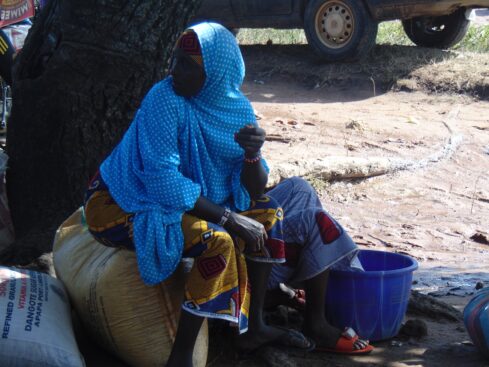
A lady waits for the next canoe at Moshe Daru
“The farmers raised the sum of twelve million Naira and built this Woro bridge which crosses the Woro River. The road leads to Degeji, Gbajibo, Kokobigbe and Corner Gbajibo, which are all farming communities,” says Yusuf Jibrin, a farmer, speaking with some excitement.
He sheds light on the cost charged per ferried item. “It costs five hundred Naira to convey a motorcycle across the river. A sack of rice costs five hundred Naira. On the other hand a sick person pays three hundred Naira to be helped across the river.”
Suleiman Mohammed, Sarkin Kasuwa (King of Market), Kaiama comments on the place of Degeji in the local government. His words “For people living in Kaiama, it’s on Friday that they go to Degeji. However, nobody can go there now. Even motorcycle taxis cannot go there. They will leave the yams until when the rains have ceased. At the other side of the bridge, the water washed away the side of the bridge. The water is too much. Degeji is a major yam growing area in Kaiama.”
According to Sarkin Kasuwa “We supply south west and the north west with soya beans, and all other grains. At the same time, we feed south west, Abuja and north west with yam flour, but we are surrounded by bad roads. People come from Kano to buy yam flour here. The best yam flour in the whole world comes from Kaiama.”
Joint Allocation
He provides evidence to show how Kaiama’s feeder roads impact on the market ” The bad roads are a huge setback. Vehicles and motorcycle taxis cannot access Degeji. You can see the market. It is not full. This year we have a bumper harvest, but we cannot evacuate the crops. We dont understand the government. The local government chairman cannot perform anything in the local government. He cannot maintain an ordinary culvert. Anytime we speak, they talk of joint allocation. They are not giving the local governments anything.”
Chairman, Kaiama local government explains “because of the bad feeder roads, transportation of goods and services to the market became difficult. Buyers from neighbouring states could not come to Kaiama for their business. This has affected the economy of the community.”
On the way forward, he suggests “Local government autonomy is the answer. This is the closest government to the people. In terms of the feeder roads, a way forward is state government intervention to purchase all the necessary heavy-duty equipment for the local government on credit, which can be gradually deducted from the allocation,” says Yusuf.
Lack of data

A canoe slowly filling up in Baruten local governement
Ibn Mohammed draws attention to a lack of data “The painful part is that up till this moment we don’t have data. We don’t even know how many bags of soya beans we produce. We have local government staff saddled with this responsibility, but if you ask them now, what is the number of soya beans produced in Kaiama last year, they can’t tell you. Soon soya beans will be in the market. On daily basis we will have ten to fifteen trailers that will convey soya beans out, yet we don’t have data. I doubt if there is any community that produced soya beans like Kaiama last year, and yet there is nothing to show for it. There is no data. If there was data we should be able to say this is what we produced last year.”
However, the local government Chairman adds “last year there was a very good harvest. The harvest included 50 to 70 metric tons of soya beans, maize and white beans.“ He did not answer questions relating to internally generated revenue, and the monthly allocation to Kaiama local government.
Security challenges
Alongside the feeder roads, security is a growing problem in Kaiama. Many lament that this has not been captured by the media “We have been facing a lot of challenges in terms of security, especially those living close to the national park. The number of our people killed or kidnapped is on the rise. Government has not said anything. We lost fifteen people in the last three months at the hand of the bandits. They pick people in their farms and ask for ransom. Those that paid ransom in the last three months are more than thirty,” says Kiwazi.
He adds “Our people are facing a lot of challenges, and this will affect the farming season. There are areas where the bandits told the villagers not to farm. If they have to farm, then they have to gather money to pay the bandits. The president has given a directive that the army should flush the bandits from Niger state, and we have a border with the national park across 5,341 square kilometres. While the security forces are fighting at the Niger end, nobody is blocking at this end.”
Kainji lake National Park
This is a point supported by Musa Idris Buko, advocate for good governance and Chairman, Coalition of Kwara North Groups (CKNG). This is a pressure group comprising five local governments in Kwara North, namely Kaiama, Baruten, Moro, Edu and Pategi. He states, “In terms of forestry resources, about 5,000 square kilometres of Kainji lake national park extends to Kaiama and Baruten local government areas, extending from Oli river, Wawa to Kaiama and parts of Baruten.”
He adds that a first-class Emir in Baruten local government has been threatened by bandits who have found refuge in the area, who wrote him a letter threatening to kidnap him. Absence of a functioning local government has created a vacuum and an ungoverned space, now filled by various individuals. Unmotorable feeder roads, an absentee political class, lack of data, incursions by bandits, and a dysfunctional local government, combine to worsen the plight of the people.
Road to Baruten
To get to Baruten local government area of Kwara state, which shares a border with the republic of Benin, you leave Kaiama and head for Igboho in Oyo state. The alternative route is to travel from Kaiama directly to Kosubosu in Baruten, but this federal road has practically disappeared. Kaiama and Baruten local governments represent 49.50 % of the entire land mass of Kwara state. It is then necessary to travel into Oyo state to get a connecting vehicle. From Igboho, a visitor can board a taxi to Ilesa Baruba in Kwara state. In addition to being the route to Ilesa Baruba, the road leads you to areas of pure scenic beauty which the setting sun helps to illuminate.
Within Ilesa Baruba there are green fields stretching into the horizon, which indicate that tourism could do well in the local government as well as in Kaiama. In addition, Baruten has the largest gazetted grazing reserves in Kwara state, being 74,000 hectares. The Kara international cattle market attracts buyers from Chad, Cameroun, Burkina Faso, Mali, Ghana and Senegal, and a dynamic economy has arisen around the market, with each young man earning up to one hundred thousand Naira each market day.
Baruten’s 400 kms of border
Buko who is contesting to represent Baruten Federal Constituency at the House of Representatives in the 2023 elections, emphasises that the local government has an extensive border with Benin republic. Hear him: “Baruten local government houses fifty percent of the 800-kilometre border stretch between Nigeria and the republic of Benin. About 400 kilometres of this is in Kwara, specifically in Baruten.”
He said that there are 71 border communities in the local government. According to the 2006 census Baruten has a population of 209,459, and its land mass is spread across 9,749 kilometres. According to the Federation Accounts Allocation Committee (FAAC), allocation to Baruten local government for the period 1999-2017 amounts to Twenty-Nine Billion, Five Hundred and Eighty Eight Million, Nine Thousand Four Hundred and Fifty Three Naira, Twenty Two Kobo. (N29,588,009,453.22).
Give away price
“By the time of the yam harvest, instead of selling a heap of yams at forty thousand Naira, it will be sold at twenty thousand Naira. The same applies to Maize. Instead of selling at forty thousand Naira, it will be sold at twenty thousand Naira,” says Alfa Nuhu, a farmer and herbalist, commenting on the way the numerous feeder roads affect harvests in Alfa Kparu, a part of Ilesa Baruba where his extensive farm helps support a large family.
Young men apply fertiliser to the crops as we discuss. They walk through lines of the beans crop pausing briefly every now and then to apply the chemical. He explains that the land yields richly, and that during the yam harvest countless trailers leave the Alfa Kparu area for other parts of the country.
‘the car sinks’
Nuhu, who states that the gift of healing runs in his family, comments on the problem around the feeder roads “There are times when to move with a motorcycle taxi will be hard. If farmers convey yams in a car, the car will sink. They would have to offload the yams, put it on their heads or convey it by some other means, and go to the market. Sometimes, a sunken car will stay at a spot for almost a week.”
He reveals that sick people from Abatabu community prefer to patronise him on account of his ability to heal, rather than go to the regular hospital. His words “At Abatabu, if they wish to go to hospital, they prefer to come to me. This is because of the bad roads that lead to Ilesa Baruba.”
“We produce two trailers of rice and maize at my farm, not to talk of the community itself. That is a good harvest. There are others around me here who produce one to two trailers each at harvest time,” indicates Nuhu.
It is mentioned that children from Dauda Kparu, a neighbouring community, cannot leave their village to go to the primary school at Alfa Kparu. Many pupils miss out on education during the rainy season, a major setback for this farming community.
‘We need tractors’
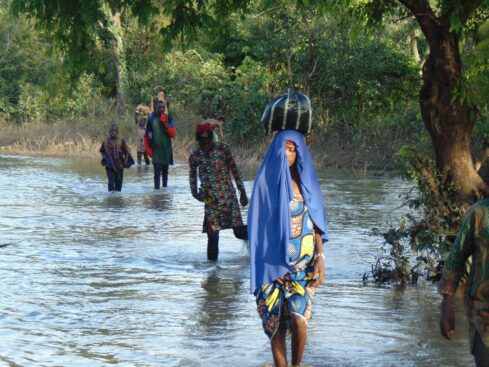
Daily life around Kamen river (1)
Zakari isa is Sarkin Noma (King of farmers) of Ilesa Baruba. He carries a dane gun, a common feature of life among the locals of Ilesa Baruba. The harvest this year has been a good one, but there are problems, he indicates.
“Bad roads affect our work. If it rains heavily, it will be hard for us to cross the rivers. We need tractors too, but the bad roads mean that the tractors won’t be able to enter our communities.”
This is a point confirmed by Ibrahim Ogun, another farmer who lives in the neighbourhood and has a soya beans farm which stretches as far as the eye can see. He says that because of the bad roads some farmers leave the ripe yam in the earth. This prevents the crop from going bad.
3 trips instead of 1
A vehicle makes the first of three trips from a nearby farm in Alfa Kparu. It conveys one hundred and twenty yams on each trip. The vehicle would have had difficulty navigating the bad roads if it had taken a full load of yams. Throughout Ilesa Baruba, all farmers exercise caution when conveying their crops out of the farms at the height of the rainy season. “The movement has to be staggered, and this is more expensive”, I am told.
Later that evening we come across a truck that had just crossed a wooden bridge on the road leading to Bwekanu, another farming community. The bridge constructed by the Bode community, is regularly flooded. Nobody can cross the bridge once it is submerged. As soon as the truck crossed it broke down, and the goods and crops at the back had to be offloaded before the trip continues.
A few minutes later we get to a small valley very close to Bwekanu. It is filled with water and there is no bridge. A young girl is busy washing clothes nearby. At the peak of the rains when the valley is full, the Bwekanu community is immediately cut off from Ilesa.
‘Blocked for months‘
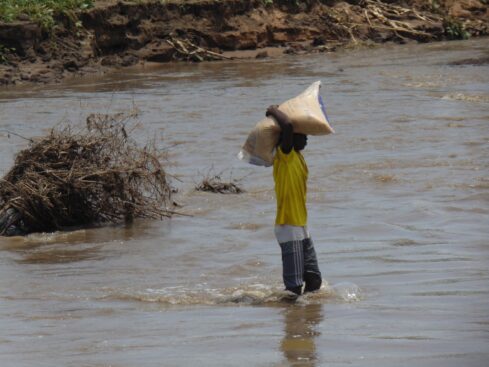
A mans slow measured walk through the river
Usman Ishaq, farmer and Sarkin Kasuwa, Ilesa Baruba, has been farming in the area for 70 years. He speaks on the challenge posed by feeder roads “When the rain is much, the farmers cannot convey their products to the market until the water reduces. At times the roads are blocked for two months, with farmers unable to convey crops to the market. It’s because the water has flooded the roads, that’s why the Kasuwan Mata (Womens market) is not full as you can see. Before 10.45 am on a normal market day, the entire market will be full. Today, you can see vast empty spaces all over the place. The area at the back of the market which is empty now, will normally be full on a regular market day.”
‘Cattle know their names’
The Ilesa-Moshi Bofa-Moshi road is flooded. Young Batonu boys from the local community assist to move cows of the pastoral Fulani through the river, holding their tails and urging them along. Cattle swim in the river and a nomad calls out the names of each cow, encouraging them to swim through, as they approach the opposite bank.
“The cattle know their names, they recognise that their names are being called, and they respond by swimming to the river bank,” reveals a local.
Fulani & Batonu
Suleiman Mukaddas is a student. He swims with the cows through the river. For each of the three market days he is paid one thousand five hundred Naira for his work with the cows. Umaru Ishaq, a farmer, says that he and the other swimmers go with the cows through the river, five times every day on each market day. This is one side of the economy that has formed around the river on account of the failed roads.
A bond has formed between the pastoral Fulani and the Batonu boys. The Fulani own cattle, while the Batonu are skilled swimmers.
Vehicles come from Kisi, Igboho, Ilesa Baruba and converge at a spot on the river bank on Moshi market days. Canoes convey traders and goods to the opposite bank for a fee. The vehicles wait for a while to convey traders back to the various towns and communities from where they came.
‘We need a bridge’
Faru Zakariyau, is a farmer and indigene of Moshi. As we wait on the river bank, a canoe draws near and discharges its passengers and cargo. Zakariyau also operates a canoe, conveying passengers to Moshi Gofa as well as Moshi. Nearby a woman who has been patiently waiting for the canoe, rises to board the canoe with her goods.
His words “The road has been in bad shape for well over twenty years. I normally charge two hundred Naira per person.” He explains that it costs four thousand Naira to convey chickens by motorcycle taxi from Moshe Daru to Ilesa, and two thousand Naira to convey four goats on a motorcycle taxi to Ilesa.
Every day numerous motorcycle taxis make the trip bearing goats and chickens from Moshi Daru up to Ilesa, speeding along bad muddy roads because they make more money with each trip.
He exclaims “We need a bridge to facilitate movement here. Farmers here have difficulty taking their crops to Ilesa from Moshi. Many have to do it in bits by using a canoe from Moshi, then they have to make use of several motorcycle taxis. This option is very expensive.”
‘I lost N1 m’
“When the farmers harvest crops, nobody will come here and buy. They dont sell at all. Their crops will go bad and they will lose a lot of money. During last year’s harvest I lost up to one million Naira on account of the bad roads. I couldn’t bring the crops out. Farmers in Moshi cannot go to Gwasoro or Okuta because the roads are blocked,” adds Zakariyau.
‘Feeder roads don’t exist’
Umar Sano Mohammed of the Ilesa Baruba Youths Forum in a facebook post, states “The feeder roads do not exist. For example, presently you cannot go to Karonji. Karonji is one of the very large yams producing areas, but we have two big rivers that you will cross. We have the river Yori and the river Mori, which sometimes you cannot cross, except by boat. How many boats do we have? The feeder roads are practically nonexistent.”
‘Farmers impoverished’
Buko comments on the activities of middle men “Once our people harvest their products they find it difficult to get it transported out to urban areas like Ilorin and Saki where the crops are needed. It makes our farmers after working hard to produce a bumper harvest, feel cheated by middle men. Most of our shea nuts, yam flour, soya beans, maize and cheese are bought cheap and taken out and sold exorbitantly. At the end of the day the farmers are deprived of their appropriate profit, and end up being impoverished.” He adds ‘Baruten has not had electricity for over twelve years now. The only community that has electricity in terms of connection to the national grid is Ilesa Baruba. Electricity only comes for two to three hours every three months. Other communities do not have electricity.”
Neglected border communities
On reasons for the neglect of border areas, Buko adds “Nigeria is positioned to provide leadership in Africa, but unfortunately Nigeria has been an irresponsible giant, it neglects its border communities. Nigeria does not give the border communities, the deserving attention. This prompted the establishment of the border communities development agency (BCDA) in 2006. It was established to bring attention closer to border communities.”
“These two local governments are very significant in terms of generating resources to the state. Unfortunately, when the resources come to Kwara state, under the joint account law, the bulk of the money ends up in the joint account. Then there is the Kwara state joint account law that empowers redistribution of that money using another formula that is inimical to the two local governments,” explains Buko.
Efforts to interview the chief executive of the BCDA, Mohammed Bio representing Baruten/Kaiama Federal Constituency in the House of Representatives, as well as Senator Sadiq Umar representing Kwara North were unsuccessful. The Kwara state Commissioner for Local government and Chieftaincy Affairs, and Chairman Baruten local government did not reply to questions sent.
Local govts bridge gaps
“Non-functional local governments in Kwara state is related to development. The local governments are complimentary to government presence at the grassroots level, and they bridge a lot of gaps. The non-democratic administration of local governments is another problem, ”says Buko. He adds “The present administration in Kwara state met a democratically elected local government structure. They constituted a new lot to superintend over the affairs of the local governments all over the state. Baruten and Kaiama are very strategic because of internally generated revenue and the federal allocation.”
‘The poorest communities’
“Borgu communites in Kebbi, Kwara, and Niger states spread across five local government areas. Agwara, Baruten, parts of Bagudo, Borgu and Kaiama are, arguably, some of the poorest communities in Nigeria in terms of both physical and human development. Development indicators such as school enrolment, maternal mortality, infant mortality, literacy levels, poverty, unemployment and the exclusion of women, among others, are considered well below national, regional and state averages,” writes Dr. Abdu.
‘Power abuse’
Buko reveals “The feeder roads constitutionally fall within the confines of, in some areas, state governments or the local government areas. The trend of non-functional local governments in Nigeria, is a very big setback to rural development. There is no way the rural communities will develop without a functional, autonomous democratically governed local government area in Nigeria. Baruten and Kaiama local governments are paying dearly under this maladministration and power abuse. ”
This report was facilitated by the Wole Soyinka Centre for Investigative Journalism WSCIJ under its Collaborative Media Engagement for Development, Inclusion and Accommodation MEDIA Project.

 Join Daily Trust WhatsApp Community For Quick Access To News and Happenings Around You.
Join Daily Trust WhatsApp Community For Quick Access To News and Happenings Around You.
